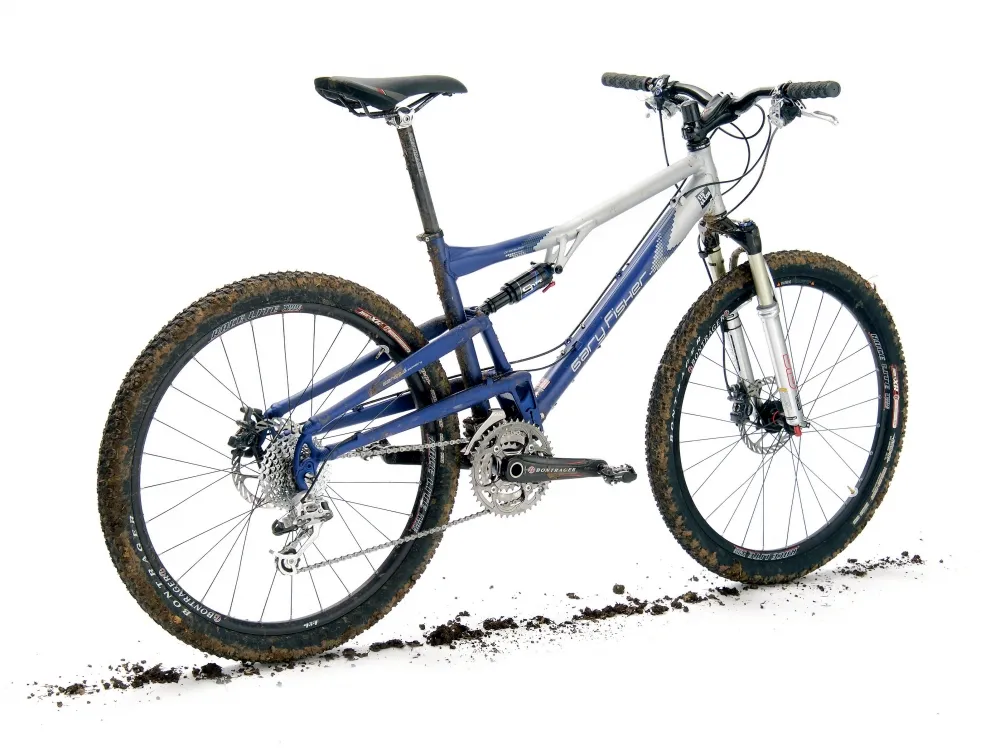The Race Day Pro Caliber from Gary Fisher is as uncompromisingly race orientated as its name suggests, with Fisher making huge efforts to reduce mass wherever possible. This well-equipped US handbuild is too spirited to just save for the start lines, though.
Frame
An incredibly agile, spring-loaded cross-country catapult
The Race Day frame might be light, but it still looks plenty fat. Hydroformed tube expansion maximises tube connection at both ends of the main tubes and main pivot mount. The large diameter (38mm) pivots themselves are also clamped into the swingarm for easy removal and replacement when the time eventually comes.
While the tubes are fat, it's still a skinny bike at heart, though. After consultation with their team riders, Fisher has even gone to the trouble of allowing a super narrow (108mm) bottom bracket axle width. This gives the narrower and potentially more efficient pedalling stance (or 'Q factor') that the racers asked for, even if you use a double not triple ring crankset.
The thin single front swingarm post joins a selection of bulged, ribbed and cutout sections to save weight. The heavily hydroformed asymmetric stays also suck inwards dramatically in the centre section for crank clearance with short BB axles. The symmetrical stays run almost parallel to the tall rear dropouts too, rather than converging - like most frames. The plates for the front shock mount are super-thin and welded onto the side (not underside) of the top tube to spread stress on the paper-thin tubing. The seat collar is a minimalist bolted clamp, too. The bridgeless back end means big mud clearance though, and you get two bottle cage mounts.
Sizing and dimensions are the same as most Fisher bikes, rather than stretched and race specific. Then again, Fisher Genesis geometry is relatively long and low anyway, so you certainly won't feel cramped.
Ride
While all of the other bikes here surprised us with the way they've retained structural stiffness despite dropping masses of skeletal weight, the Fisher feels super flexy from the first pedal stroke.
Stomp the pedal and the whole bike seems to bow and coil underneath you before springing forward down the trail. The short stem, tight back end and steep angled Genesis geometry also gives a super light steering feel, letting you really rip the bike into corners. Bite the front wheel in hard though, and the bike flexes along its whole length - laterally down the long main tubes and those skinny stay centre sections, and rotationally around the swingarm front and dropouts. Add the effect of the super skimpy SID fork and this whip makes it a real handful to keep straight or on line.
Despite constant corrections and as much bike bullying as we could manage, it wandered about loosely within a metre corridor on rocky downhills or half a metre on similar climbs. Under really heavy cornering loads it even changed gear and two separate wheel paths were obvious if we followed it through cross rutted or cobbly sections. The tight-feeling Manitou shock offers little small bump 'suction' and with only 3in of travel, it's not a natural rock eater, either.
The result is really frightening on the first few descents, but relax and work with it and you'll find it actually works out its own way down the hill. Tune into the twang and you'll also feel yourself leaping and reloading from one corner to the next on singletrack.
The single pivot suspension also stands up under power and braking to further accentuate the 3D sensation, making this one of the most lively bikes we've ever ridden.
Equipment
It's a while since we've ridden a bike with SIDs and we'd forgotten how vague their attitude to line holding and accurate tracking was. The full carbon-topped World Cups are silly light though, and with positive and negative air springs, plus adjustable platform threshold damping on both fork top and a Pop Loc Adjust handlebar remote, you can make them feel just how you want. SRAM X.0 shifters and Juicy Seven brakes are very adjustable too as well as offering gorgeously sharp clarity to both shifting and braking.
Bontrager's carbon armed X Lite crank adds more visual value, although practical advantages are more doubtful and its prettiness won't last long. There's room for a few more grams to go in both the Bontrager saddle and the Race Lite wheelset too, although Tubeless Ready rims and tyres are a potentially useful touch.
The ACX tyres are a real dry weather setup too, as they felt perilous on any wet roots we skidded across, even compared to the other race tyres here.
The beefy Bontrager carbon stem and oversize bars add at least some stiffness into the otherwise fluid feel. However, the featherweight front end pops up very easily on climbs, which makes the Race Day even more wayward uphill unless you're careful. You can't fault the level of kit provided for the complete bike price, though.
The best way we can think to describe the ride of the Race Day is 'like Tigger'. If an incredibly agile, three dimensionally spring-loaded cross country catapult sounds like the barrel of laughs it easily can be, then you'll love it. If you're a naturally smooth, skilful or just careful rider, then it's a superb value, highlight loaded package with proper ultra light potential. If you like your bikes stiff and surefooted though, stay well clear.





